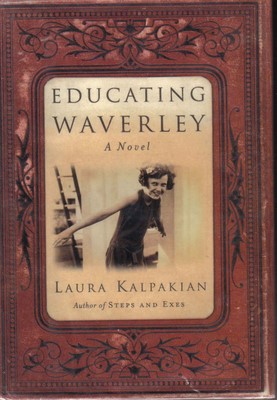Fictional island feels real
Educating Waverley © 2002 Laura Kalpakian
© 2006 Beth HelstienI gave Puget Sound author Laura Kalpakian a second chance when I decided to review Educating Waverley. I had two reasons: I love reading fictionalized renditions of familiar places, especially our San Juan Islands. Also, a library trustee recommended it, and in my years here I have always been impressed with the thoughtfulness with which the library board guides the policy of the public library. (If you are happy with our library, in some part you can thank these unelected, unpaid leaders for their service.)
I enjoyed Educating Waverley for its rich sense of time and place and for the way the relationships between the characters unfolded. I turned to Laura Kalpakian initially because I loved the title of her book Steps and Exes. I thought “that book might explain my family!” Unfortunately, while it contained a few great moments, in the end I felt let down by the book. Perhaps I had expected too much from it, but its dysfunctional family wasn’t mine, and I was glad I didn’t have to live them. Maybe I should write another book of the same title, or call it Who’s whose? which would explain all the various ways islanders are related.
Educating Waverley is set on an imaginary Isadora Island (think Orcas Island) in Puget Sound, initially inhabited by loggers working for the timber baron family, one member of whose next generation starts a school for girls after World War I. The island is full of quirky and even eccentric characters, old friendships and longstanding hatreds in a small town. (Sound familiar? Can you recognize a little island life?)
The book alternates between different time periods, the present, World War II on Isadora Island, and World War I in France. Novels set in alternate locations or time periods are sometimes choppy, but I felt hungry to know more of the characters pasts and was ready for flashbacks. And the way these characters’ pasts shapes their choices in the present rings true to me. The portions of the book set in the past retain tinges of that filmy, dreamy feeling of memory, while the present times are not stark, but are less magical and harsher than the past.
The novel also includes themes that may be troubling to some readers: erotic scenes—and what could be sacrilege to some—the worship of the Chocolate God. Set during and immediately following the Great War, briefly it is the story of a girl’s school friendship which influences the entire course of Waverley’s life.
The novel raises interesting ideas: What are uniquely American values and potential contributions as opposed to those of continental Europe? What role can women play in the world? What about love and romance?
Educating Waverley doesn’t succeed entirely through changes in time, setting, and point-of-view, but it captures enough of the spirit of the islands and creates characters that will live on in your imagination. It may not be a great novel, but it is a certainly good one.
Educating Waverley, like all books reviewed here, may be found at the San Juan Island Library.
